PPMP20013: Developing a Tender Request for a Mining Project
VerifiedAdded on 2023/06/11
|14
|3350
|411
Report
AI Summary
This report presents a tender request developed for a mining project, aligning with AS 4120-1994 standards as part of the PPMP20013 assessment. It defines the project scope within the context of mining, plant, or large assets, explains the project justification and contract process, and addresses ethical considerations throughout the project lifecycle. The document details tendering procedures, including the tender document, selection process, methods, inquiries, amendments, receipts, closing, and evaluation. Furthermore, it outlines the obligations of tenderers, emphasizing genuine belief, return of documents, confidentiality, and contractual terms such as service of notices, assignment, subcontracting, statutory requirements, examination, testing, progress programming, suspension, delay costs, defects liability, certificates, and payments. The report aims to provide a comprehensive overview of the tender process for effective project management and compliance with relevant Australian standards. Desklib offers a range of similar documents and study tools to aid students in their academic pursuits.
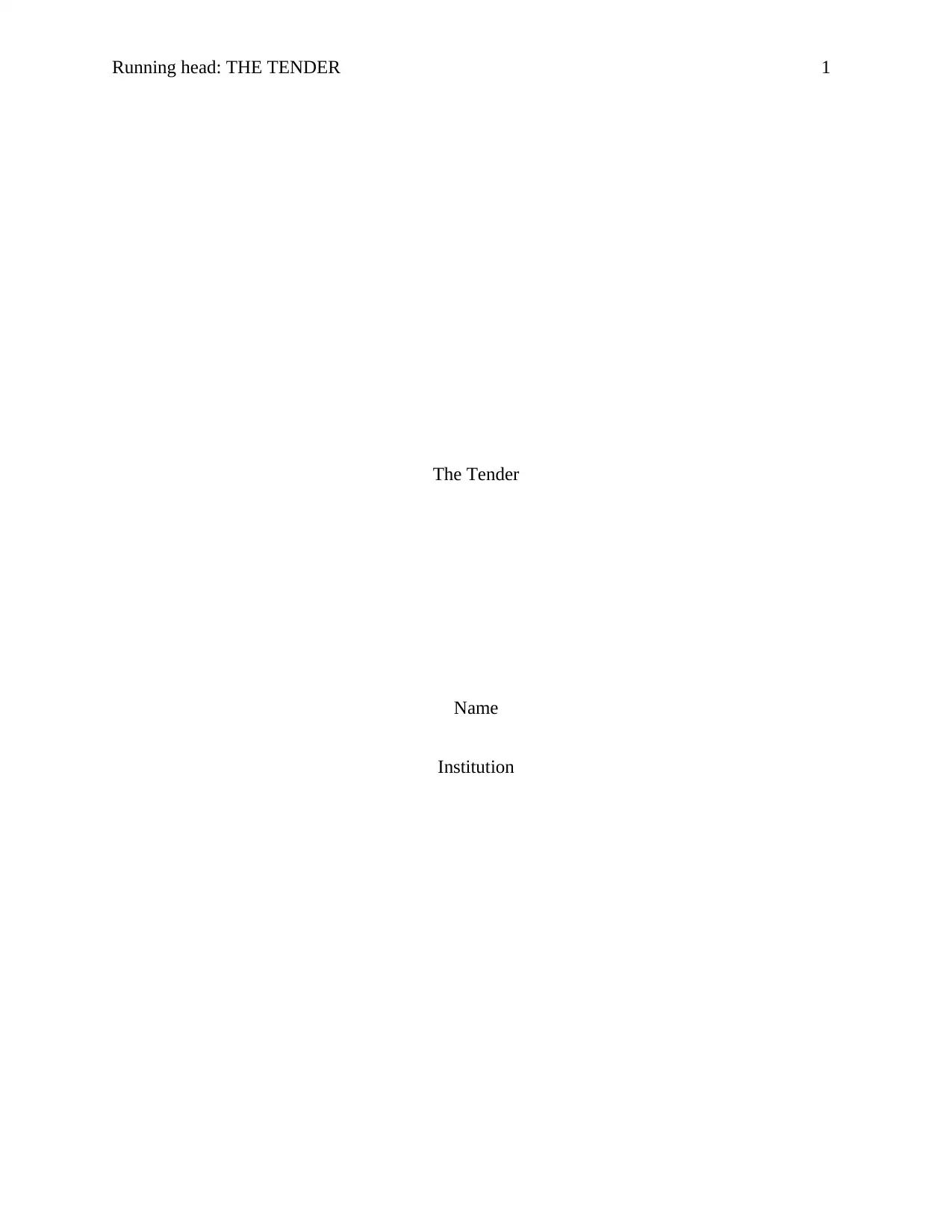
Running head: THE TENDER 1
The Tender
Name
Institution
The Tender
Name
Institution
Paraphrase This Document
Need a fresh take? Get an instant paraphrase of this document with our AI Paraphraser
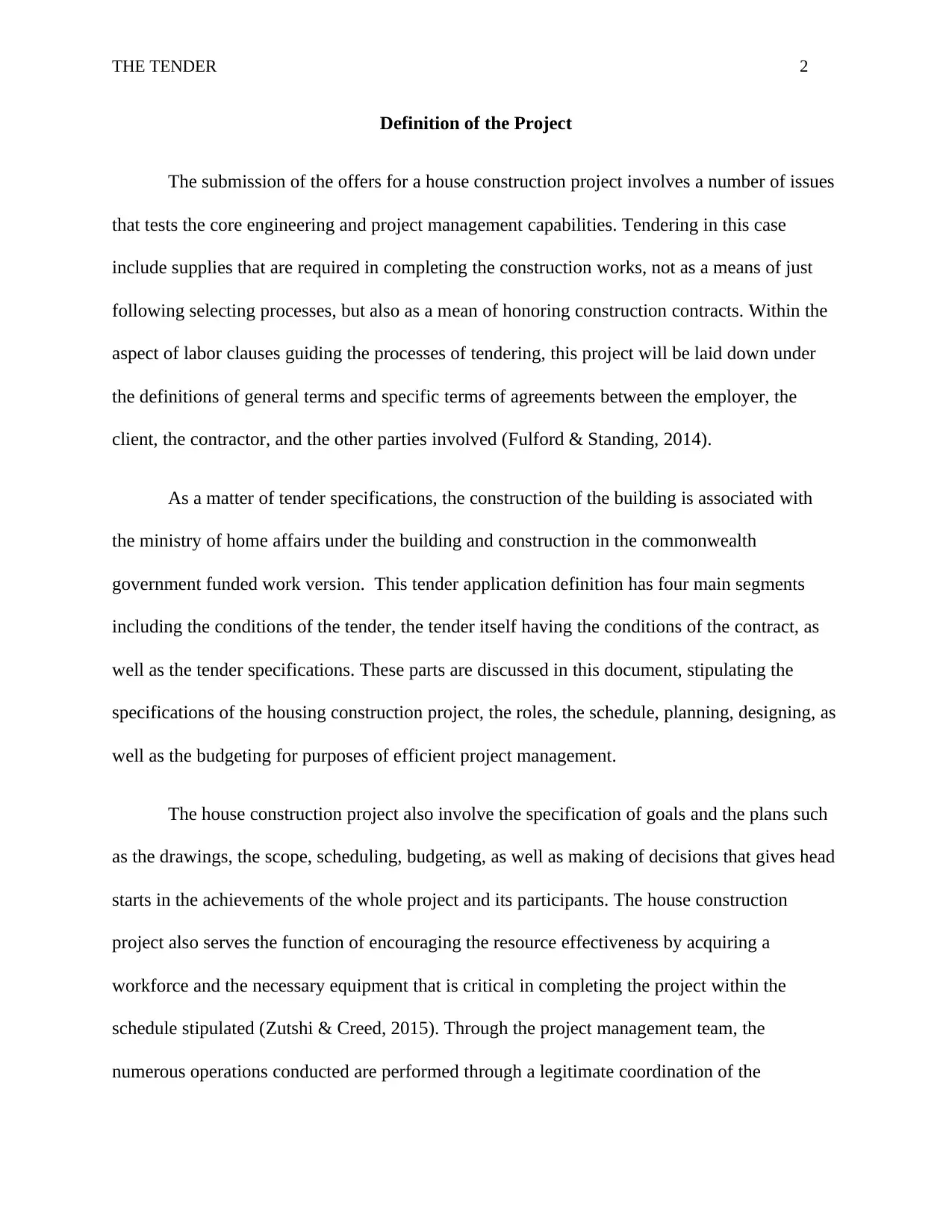
THE TENDER 2
Definition of the Project
The submission of the offers for a house construction project involves a number of issues
that tests the core engineering and project management capabilities. Tendering in this case
include supplies that are required in completing the construction works, not as a means of just
following selecting processes, but also as a mean of honoring construction contracts. Within the
aspect of labor clauses guiding the processes of tendering, this project will be laid down under
the definitions of general terms and specific terms of agreements between the employer, the
client, the contractor, and the other parties involved (Fulford & Standing, 2014).
As a matter of tender specifications, the construction of the building is associated with
the ministry of home affairs under the building and construction in the commonwealth
government funded work version. This tender application definition has four main segments
including the conditions of the tender, the tender itself having the conditions of the contract, as
well as the tender specifications. These parts are discussed in this document, stipulating the
specifications of the housing construction project, the roles, the schedule, planning, designing, as
well as the budgeting for purposes of efficient project management.
The house construction project also involve the specification of goals and the plans such
as the drawings, the scope, scheduling, budgeting, as well as making of decisions that gives head
starts in the achievements of the whole project and its participants. The house construction
project also serves the function of encouraging the resource effectiveness by acquiring a
workforce and the necessary equipment that is critical in completing the project within the
schedule stipulated (Zutshi & Creed, 2015). Through the project management team, the
numerous operations conducted are performed through a legitimate coordination of the
Definition of the Project
The submission of the offers for a house construction project involves a number of issues
that tests the core engineering and project management capabilities. Tendering in this case
include supplies that are required in completing the construction works, not as a means of just
following selecting processes, but also as a mean of honoring construction contracts. Within the
aspect of labor clauses guiding the processes of tendering, this project will be laid down under
the definitions of general terms and specific terms of agreements between the employer, the
client, the contractor, and the other parties involved (Fulford & Standing, 2014).
As a matter of tender specifications, the construction of the building is associated with
the ministry of home affairs under the building and construction in the commonwealth
government funded work version. This tender application definition has four main segments
including the conditions of the tender, the tender itself having the conditions of the contract, as
well as the tender specifications. These parts are discussed in this document, stipulating the
specifications of the housing construction project, the roles, the schedule, planning, designing, as
well as the budgeting for purposes of efficient project management.
The house construction project also involve the specification of goals and the plans such
as the drawings, the scope, scheduling, budgeting, as well as making of decisions that gives head
starts in the achievements of the whole project and its participants. The house construction
project also serves the function of encouraging the resource effectiveness by acquiring a
workforce and the necessary equipment that is critical in completing the project within the
schedule stipulated (Zutshi & Creed, 2015). Through the project management team, the
numerous operations conducted are performed through a legitimate coordination of the
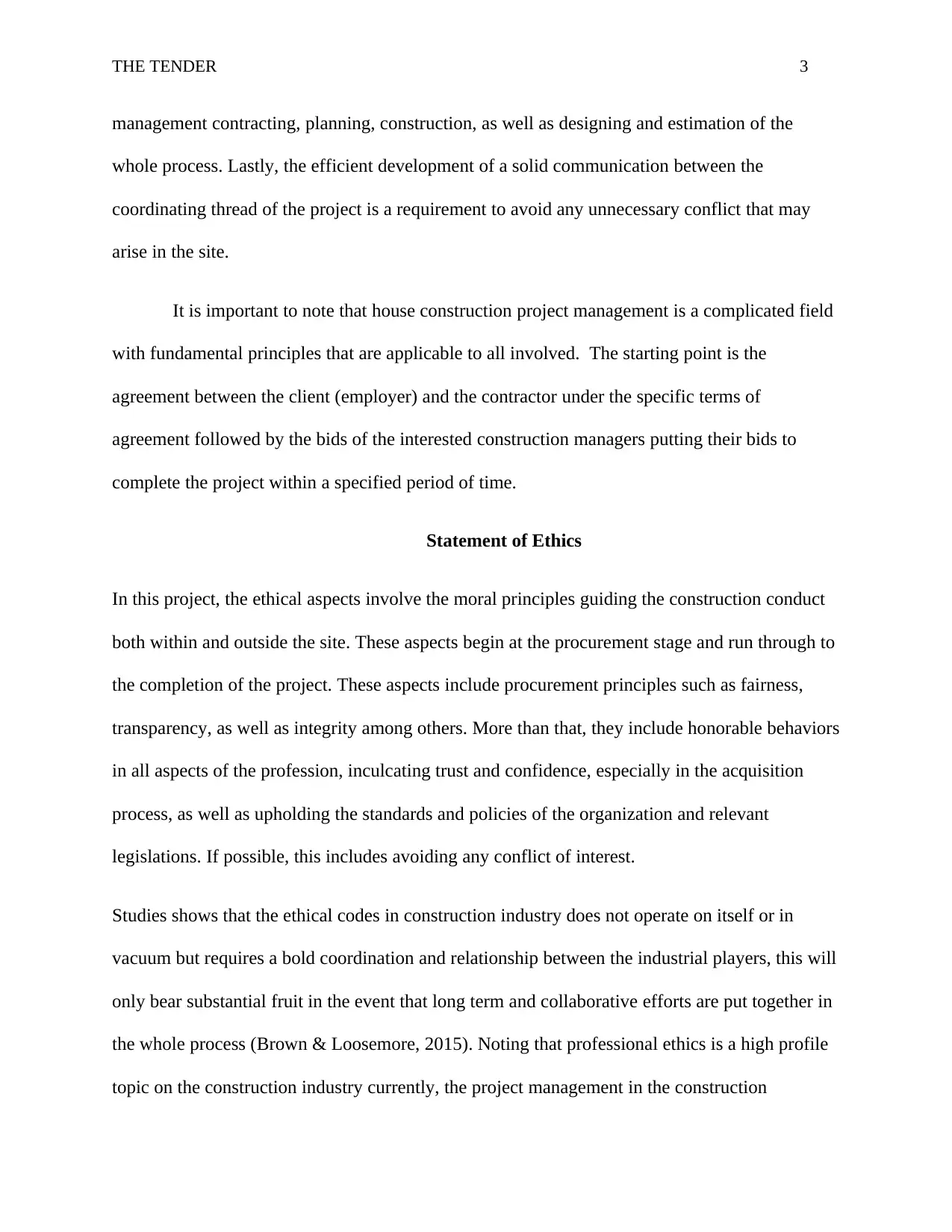
THE TENDER 3
management contracting, planning, construction, as well as designing and estimation of the
whole process. Lastly, the efficient development of a solid communication between the
coordinating thread of the project is a requirement to avoid any unnecessary conflict that may
arise in the site.
It is important to note that house construction project management is a complicated field
with fundamental principles that are applicable to all involved. The starting point is the
agreement between the client (employer) and the contractor under the specific terms of
agreement followed by the bids of the interested construction managers putting their bids to
complete the project within a specified period of time.
Statement of Ethics
In this project, the ethical aspects involve the moral principles guiding the construction conduct
both within and outside the site. These aspects begin at the procurement stage and run through to
the completion of the project. These aspects include procurement principles such as fairness,
transparency, as well as integrity among others. More than that, they include honorable behaviors
in all aspects of the profession, inculcating trust and confidence, especially in the acquisition
process, as well as upholding the standards and policies of the organization and relevant
legislations. If possible, this includes avoiding any conflict of interest.
Studies shows that the ethical codes in construction industry does not operate on itself or in
vacuum but requires a bold coordination and relationship between the industrial players, this will
only bear substantial fruit in the event that long term and collaborative efforts are put together in
the whole process (Brown & Loosemore, 2015). Noting that professional ethics is a high profile
topic on the construction industry currently, the project management in the construction
management contracting, planning, construction, as well as designing and estimation of the
whole process. Lastly, the efficient development of a solid communication between the
coordinating thread of the project is a requirement to avoid any unnecessary conflict that may
arise in the site.
It is important to note that house construction project management is a complicated field
with fundamental principles that are applicable to all involved. The starting point is the
agreement between the client (employer) and the contractor under the specific terms of
agreement followed by the bids of the interested construction managers putting their bids to
complete the project within a specified period of time.
Statement of Ethics
In this project, the ethical aspects involve the moral principles guiding the construction conduct
both within and outside the site. These aspects begin at the procurement stage and run through to
the completion of the project. These aspects include procurement principles such as fairness,
transparency, as well as integrity among others. More than that, they include honorable behaviors
in all aspects of the profession, inculcating trust and confidence, especially in the acquisition
process, as well as upholding the standards and policies of the organization and relevant
legislations. If possible, this includes avoiding any conflict of interest.
Studies shows that the ethical codes in construction industry does not operate on itself or in
vacuum but requires a bold coordination and relationship between the industrial players, this will
only bear substantial fruit in the event that long term and collaborative efforts are put together in
the whole process (Brown & Loosemore, 2015). Noting that professional ethics is a high profile
topic on the construction industry currently, the project management in the construction
⊘ This is a preview!⊘
Do you want full access?
Subscribe today to unlock all pages.

Trusted by 1+ million students worldwide
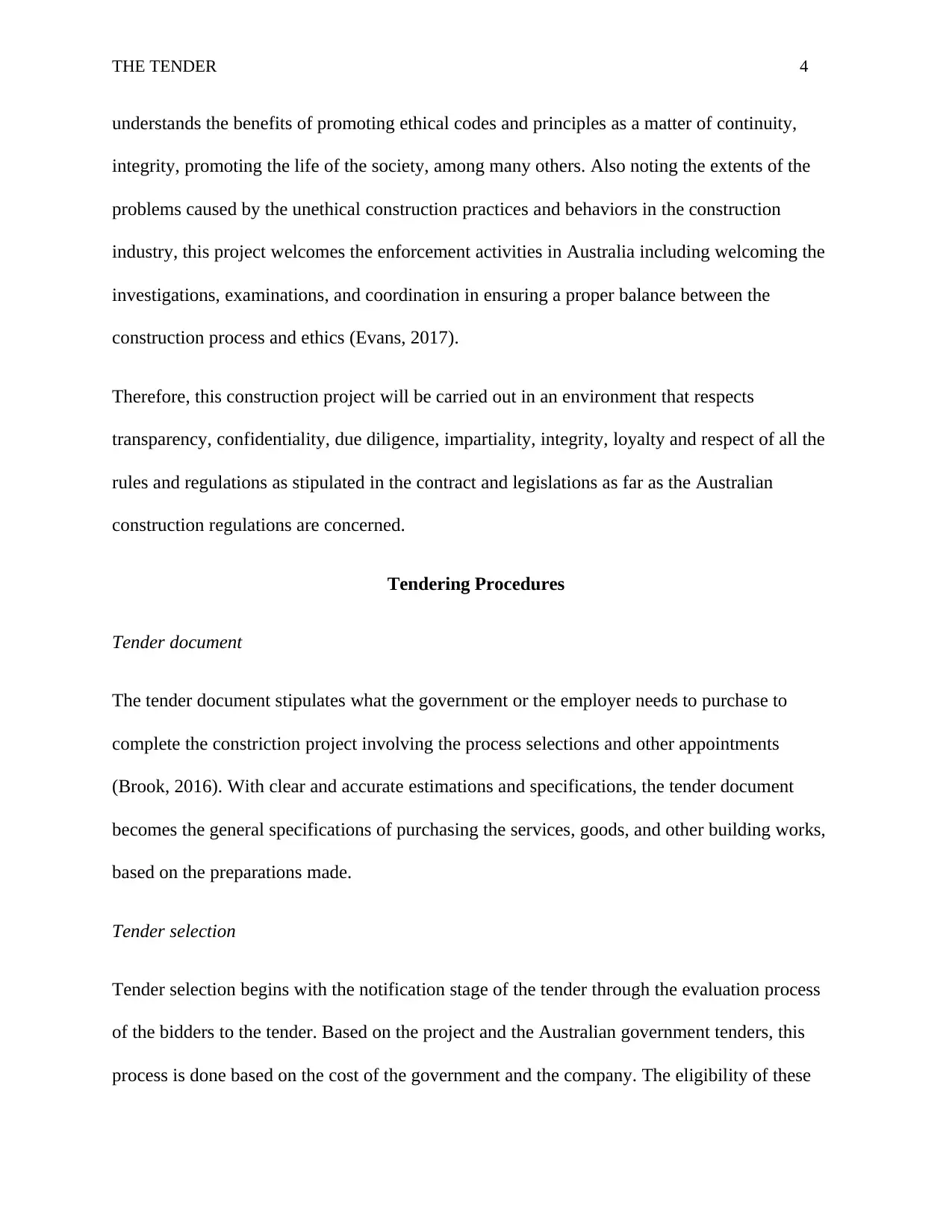
THE TENDER 4
understands the benefits of promoting ethical codes and principles as a matter of continuity,
integrity, promoting the life of the society, among many others. Also noting the extents of the
problems caused by the unethical construction practices and behaviors in the construction
industry, this project welcomes the enforcement activities in Australia including welcoming the
investigations, examinations, and coordination in ensuring a proper balance between the
construction process and ethics (Evans, 2017).
Therefore, this construction project will be carried out in an environment that respects
transparency, confidentiality, due diligence, impartiality, integrity, loyalty and respect of all the
rules and regulations as stipulated in the contract and legislations as far as the Australian
construction regulations are concerned.
Tendering Procedures
Tender document
The tender document stipulates what the government or the employer needs to purchase to
complete the constriction project involving the process selections and other appointments
(Brook, 2016). With clear and accurate estimations and specifications, the tender document
becomes the general specifications of purchasing the services, goods, and other building works,
based on the preparations made.
Tender selection
Tender selection begins with the notification stage of the tender through the evaluation process
of the bidders to the tender. Based on the project and the Australian government tenders, this
process is done based on the cost of the government and the company. The eligibility of these
understands the benefits of promoting ethical codes and principles as a matter of continuity,
integrity, promoting the life of the society, among many others. Also noting the extents of the
problems caused by the unethical construction practices and behaviors in the construction
industry, this project welcomes the enforcement activities in Australia including welcoming the
investigations, examinations, and coordination in ensuring a proper balance between the
construction process and ethics (Evans, 2017).
Therefore, this construction project will be carried out in an environment that respects
transparency, confidentiality, due diligence, impartiality, integrity, loyalty and respect of all the
rules and regulations as stipulated in the contract and legislations as far as the Australian
construction regulations are concerned.
Tendering Procedures
Tender document
The tender document stipulates what the government or the employer needs to purchase to
complete the constriction project involving the process selections and other appointments
(Brook, 2016). With clear and accurate estimations and specifications, the tender document
becomes the general specifications of purchasing the services, goods, and other building works,
based on the preparations made.
Tender selection
Tender selection begins with the notification stage of the tender through the evaluation process
of the bidders to the tender. Based on the project and the Australian government tenders, this
process is done based on the cost of the government and the company. The eligibility of these
Paraphrase This Document
Need a fresh take? Get an instant paraphrase of this document with our AI Paraphraser
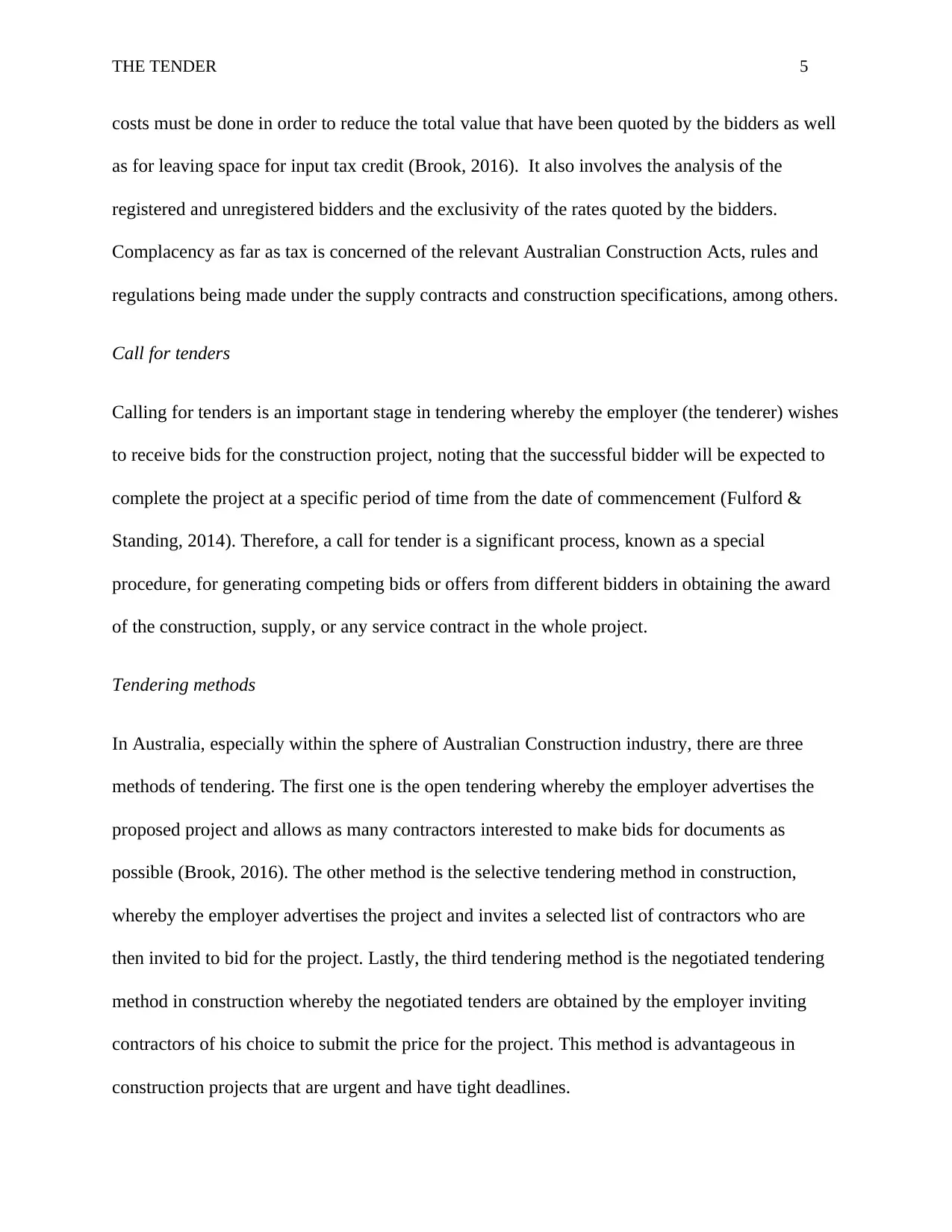
THE TENDER 5
costs must be done in order to reduce the total value that have been quoted by the bidders as well
as for leaving space for input tax credit (Brook, 2016). It also involves the analysis of the
registered and unregistered bidders and the exclusivity of the rates quoted by the bidders.
Complacency as far as tax is concerned of the relevant Australian Construction Acts, rules and
regulations being made under the supply contracts and construction specifications, among others.
Call for tenders
Calling for tenders is an important stage in tendering whereby the employer (the tenderer) wishes
to receive bids for the construction project, noting that the successful bidder will be expected to
complete the project at a specific period of time from the date of commencement (Fulford &
Standing, 2014). Therefore, a call for tender is a significant process, known as a special
procedure, for generating competing bids or offers from different bidders in obtaining the award
of the construction, supply, or any service contract in the whole project.
Tendering methods
In Australia, especially within the sphere of Australian Construction industry, there are three
methods of tendering. The first one is the open tendering whereby the employer advertises the
proposed project and allows as many contractors interested to make bids for documents as
possible (Brook, 2016). The other method is the selective tendering method in construction,
whereby the employer advertises the project and invites a selected list of contractors who are
then invited to bid for the project. Lastly, the third tendering method is the negotiated tendering
method in construction whereby the negotiated tenders are obtained by the employer inviting
contractors of his choice to submit the price for the project. This method is advantageous in
construction projects that are urgent and have tight deadlines.
costs must be done in order to reduce the total value that have been quoted by the bidders as well
as for leaving space for input tax credit (Brook, 2016). It also involves the analysis of the
registered and unregistered bidders and the exclusivity of the rates quoted by the bidders.
Complacency as far as tax is concerned of the relevant Australian Construction Acts, rules and
regulations being made under the supply contracts and construction specifications, among others.
Call for tenders
Calling for tenders is an important stage in tendering whereby the employer (the tenderer) wishes
to receive bids for the construction project, noting that the successful bidder will be expected to
complete the project at a specific period of time from the date of commencement (Fulford &
Standing, 2014). Therefore, a call for tender is a significant process, known as a special
procedure, for generating competing bids or offers from different bidders in obtaining the award
of the construction, supply, or any service contract in the whole project.
Tendering methods
In Australia, especially within the sphere of Australian Construction industry, there are three
methods of tendering. The first one is the open tendering whereby the employer advertises the
proposed project and allows as many contractors interested to make bids for documents as
possible (Brook, 2016). The other method is the selective tendering method in construction,
whereby the employer advertises the project and invites a selected list of contractors who are
then invited to bid for the project. Lastly, the third tendering method is the negotiated tendering
method in construction whereby the negotiated tenders are obtained by the employer inviting
contractors of his choice to submit the price for the project. This method is advantageous in
construction projects that are urgent and have tight deadlines.
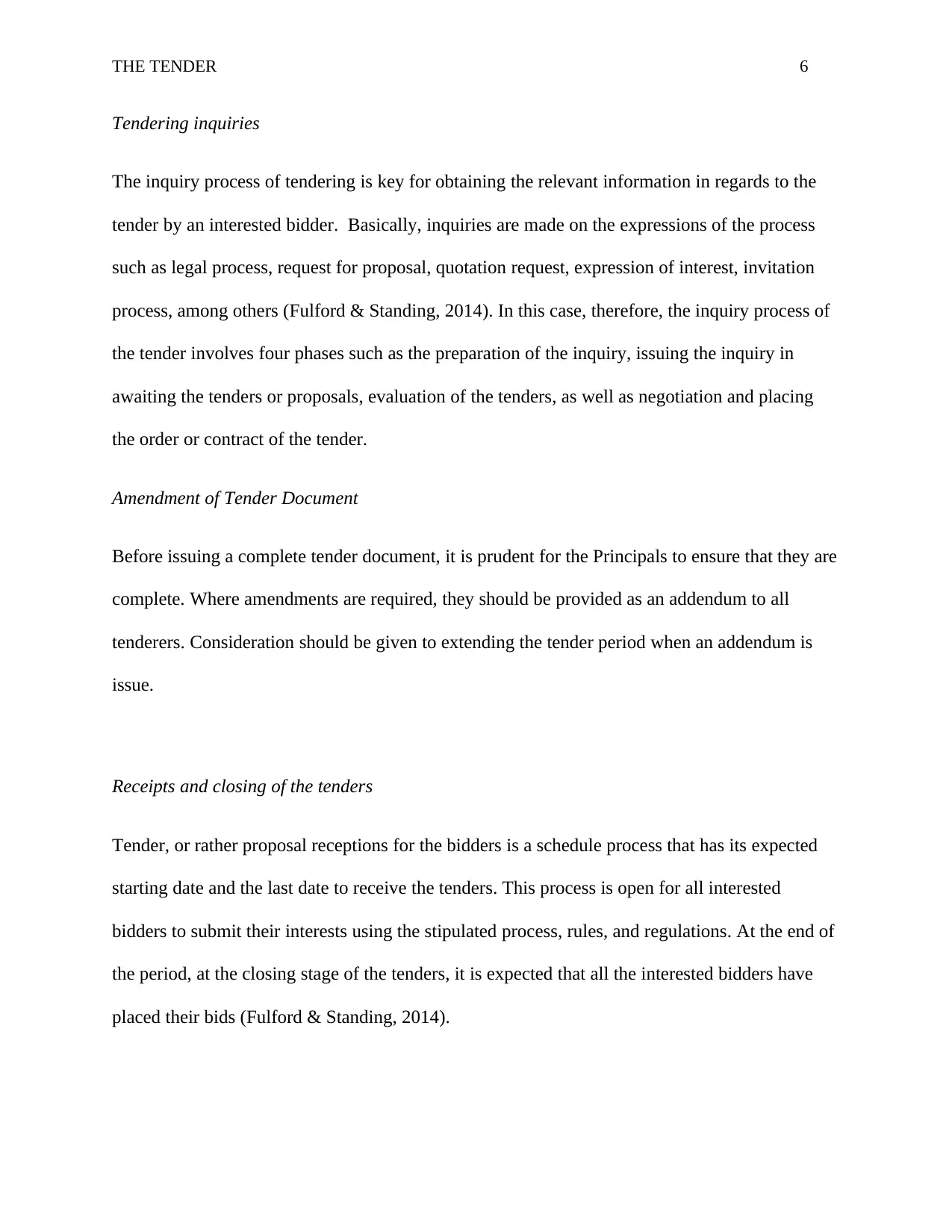
THE TENDER 6
Tendering inquiries
The inquiry process of tendering is key for obtaining the relevant information in regards to the
tender by an interested bidder. Basically, inquiries are made on the expressions of the process
such as legal process, request for proposal, quotation request, expression of interest, invitation
process, among others (Fulford & Standing, 2014). In this case, therefore, the inquiry process of
the tender involves four phases such as the preparation of the inquiry, issuing the inquiry in
awaiting the tenders or proposals, evaluation of the tenders, as well as negotiation and placing
the order or contract of the tender.
Amendment of Tender Document
Before issuing a complete tender document, it is prudent for the Principals to ensure that they are
complete. Where amendments are required, they should be provided as an addendum to all
tenderers. Consideration should be given to extending the tender period when an addendum is
issue.
Receipts and closing of the tenders
Tender, or rather proposal receptions for the bidders is a schedule process that has its expected
starting date and the last date to receive the tenders. This process is open for all interested
bidders to submit their interests using the stipulated process, rules, and regulations. At the end of
the period, at the closing stage of the tenders, it is expected that all the interested bidders have
placed their bids (Fulford & Standing, 2014).
Tendering inquiries
The inquiry process of tendering is key for obtaining the relevant information in regards to the
tender by an interested bidder. Basically, inquiries are made on the expressions of the process
such as legal process, request for proposal, quotation request, expression of interest, invitation
process, among others (Fulford & Standing, 2014). In this case, therefore, the inquiry process of
the tender involves four phases such as the preparation of the inquiry, issuing the inquiry in
awaiting the tenders or proposals, evaluation of the tenders, as well as negotiation and placing
the order or contract of the tender.
Amendment of Tender Document
Before issuing a complete tender document, it is prudent for the Principals to ensure that they are
complete. Where amendments are required, they should be provided as an addendum to all
tenderers. Consideration should be given to extending the tender period when an addendum is
issue.
Receipts and closing of the tenders
Tender, or rather proposal receptions for the bidders is a schedule process that has its expected
starting date and the last date to receive the tenders. This process is open for all interested
bidders to submit their interests using the stipulated process, rules, and regulations. At the end of
the period, at the closing stage of the tenders, it is expected that all the interested bidders have
placed their bids (Fulford & Standing, 2014).
⊘ This is a preview!⊘
Do you want full access?
Subscribe today to unlock all pages.

Trusted by 1+ million students worldwide
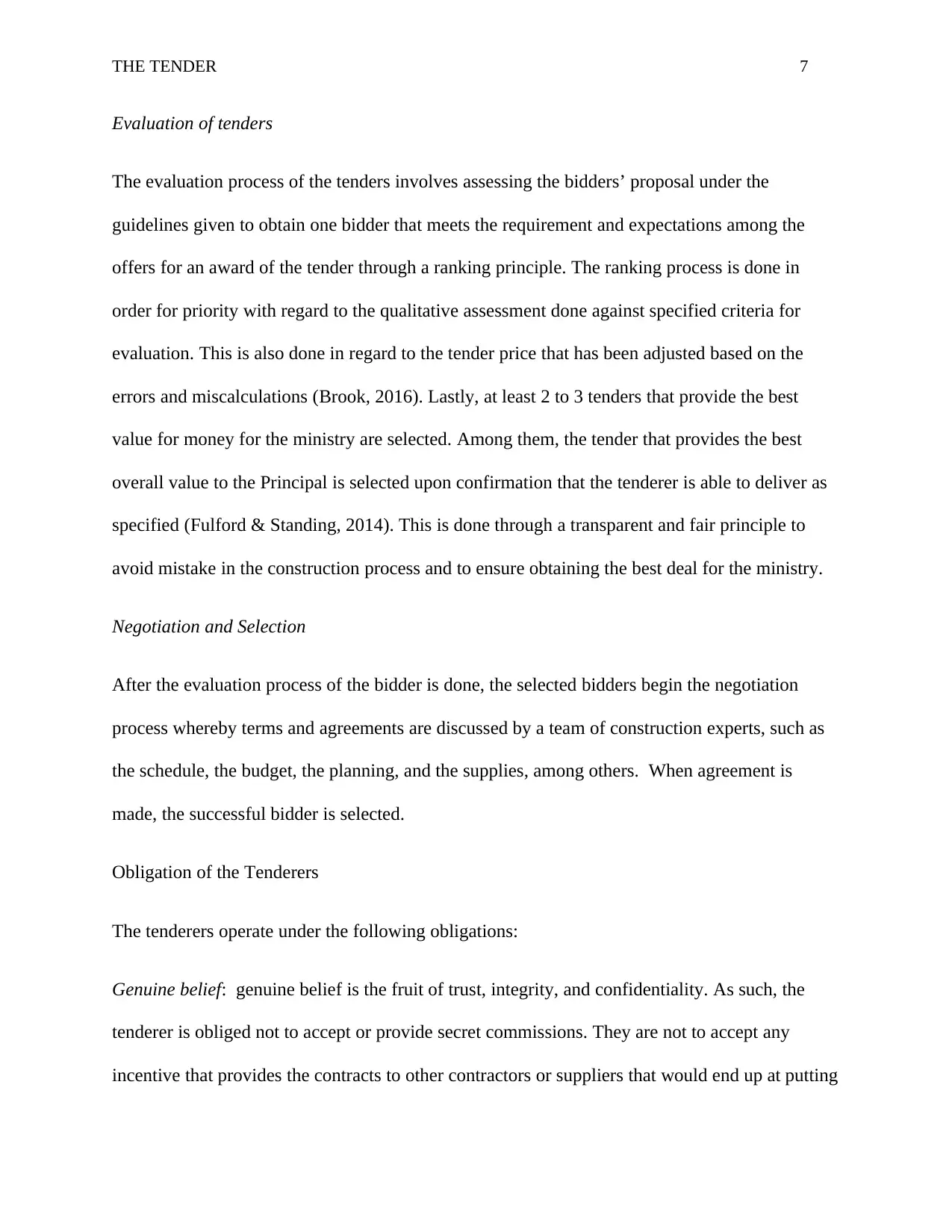
THE TENDER 7
Evaluation of tenders
The evaluation process of the tenders involves assessing the bidders’ proposal under the
guidelines given to obtain one bidder that meets the requirement and expectations among the
offers for an award of the tender through a ranking principle. The ranking process is done in
order for priority with regard to the qualitative assessment done against specified criteria for
evaluation. This is also done in regard to the tender price that has been adjusted based on the
errors and miscalculations (Brook, 2016). Lastly, at least 2 to 3 tenders that provide the best
value for money for the ministry are selected. Among them, the tender that provides the best
overall value to the Principal is selected upon confirmation that the tenderer is able to deliver as
specified (Fulford & Standing, 2014). This is done through a transparent and fair principle to
avoid mistake in the construction process and to ensure obtaining the best deal for the ministry.
Negotiation and Selection
After the evaluation process of the bidder is done, the selected bidders begin the negotiation
process whereby terms and agreements are discussed by a team of construction experts, such as
the schedule, the budget, the planning, and the supplies, among others. When agreement is
made, the successful bidder is selected.
Obligation of the Tenderers
The tenderers operate under the following obligations:
Genuine belief: genuine belief is the fruit of trust, integrity, and confidentiality. As such, the
tenderer is obliged not to accept or provide secret commissions. They are not to accept any
incentive that provides the contracts to other contractors or suppliers that would end up at putting
Evaluation of tenders
The evaluation process of the tenders involves assessing the bidders’ proposal under the
guidelines given to obtain one bidder that meets the requirement and expectations among the
offers for an award of the tender through a ranking principle. The ranking process is done in
order for priority with regard to the qualitative assessment done against specified criteria for
evaluation. This is also done in regard to the tender price that has been adjusted based on the
errors and miscalculations (Brook, 2016). Lastly, at least 2 to 3 tenders that provide the best
value for money for the ministry are selected. Among them, the tender that provides the best
overall value to the Principal is selected upon confirmation that the tenderer is able to deliver as
specified (Fulford & Standing, 2014). This is done through a transparent and fair principle to
avoid mistake in the construction process and to ensure obtaining the best deal for the ministry.
Negotiation and Selection
After the evaluation process of the bidder is done, the selected bidders begin the negotiation
process whereby terms and agreements are discussed by a team of construction experts, such as
the schedule, the budget, the planning, and the supplies, among others. When agreement is
made, the successful bidder is selected.
Obligation of the Tenderers
The tenderers operate under the following obligations:
Genuine belief: genuine belief is the fruit of trust, integrity, and confidentiality. As such, the
tenderer is obliged not to accept or provide secret commissions. They are not to accept any
incentive that provides the contracts to other contractors or suppliers that would end up at putting
Paraphrase This Document
Need a fresh take? Get an instant paraphrase of this document with our AI Paraphraser
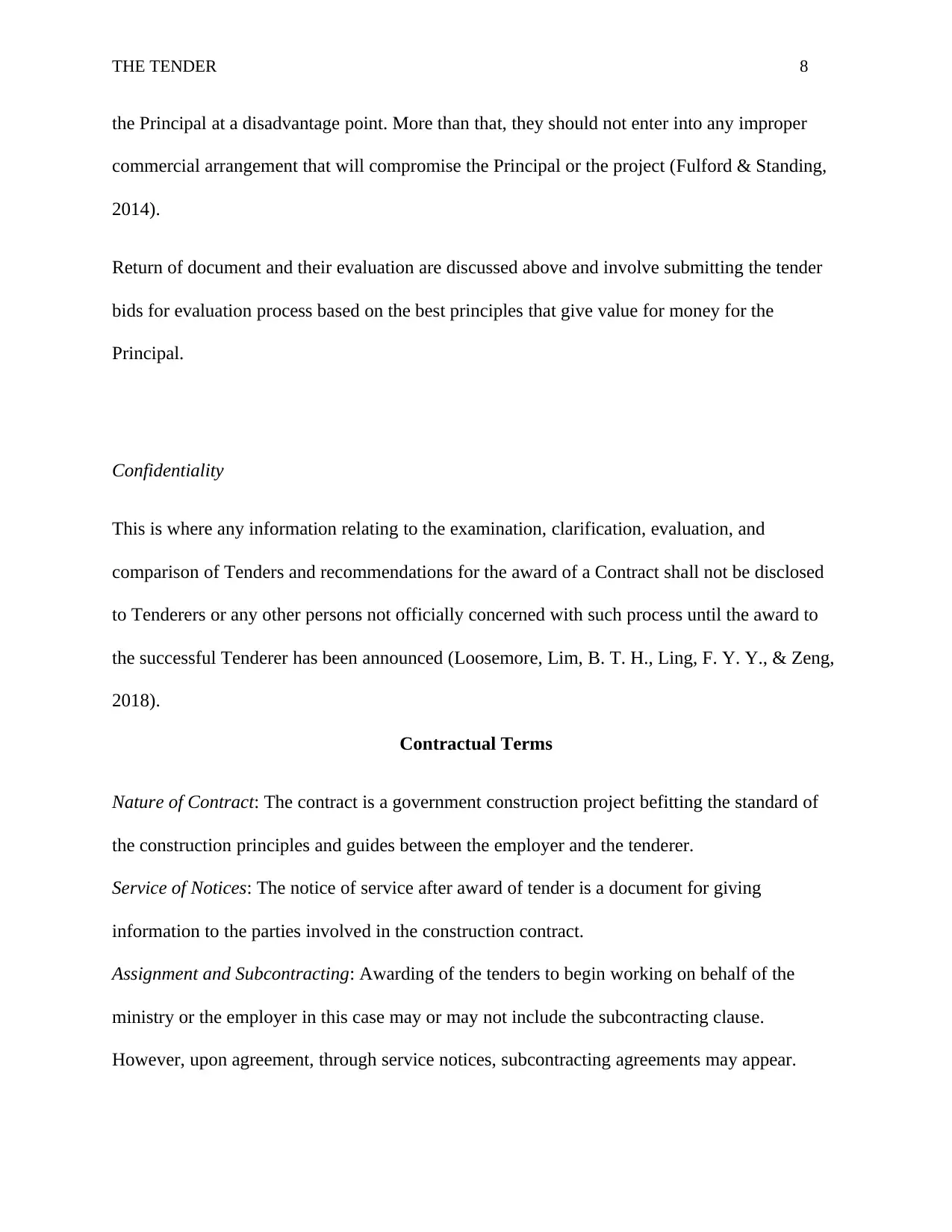
THE TENDER 8
the Principal at a disadvantage point. More than that, they should not enter into any improper
commercial arrangement that will compromise the Principal or the project (Fulford & Standing,
2014).
Return of document and their evaluation are discussed above and involve submitting the tender
bids for evaluation process based on the best principles that give value for money for the
Principal.
Confidentiality
This is where any information relating to the examination, clarification, evaluation, and
comparison of Tenders and recommendations for the award of a Contract shall not be disclosed
to Tenderers or any other persons not officially concerned with such process until the award to
the successful Tenderer has been announced (Loosemore, Lim, B. T. H., Ling, F. Y. Y., & Zeng,
2018).
Contractual Terms
Nature of Contract: The contract is a government construction project befitting the standard of
the construction principles and guides between the employer and the tenderer.
Service of Notices: The notice of service after award of tender is a document for giving
information to the parties involved in the construction contract.
Assignment and Subcontracting: Awarding of the tenders to begin working on behalf of the
ministry or the employer in this case may or may not include the subcontracting clause.
However, upon agreement, through service notices, subcontracting agreements may appear.
the Principal at a disadvantage point. More than that, they should not enter into any improper
commercial arrangement that will compromise the Principal or the project (Fulford & Standing,
2014).
Return of document and their evaluation are discussed above and involve submitting the tender
bids for evaluation process based on the best principles that give value for money for the
Principal.
Confidentiality
This is where any information relating to the examination, clarification, evaluation, and
comparison of Tenders and recommendations for the award of a Contract shall not be disclosed
to Tenderers or any other persons not officially concerned with such process until the award to
the successful Tenderer has been announced (Loosemore, Lim, B. T. H., Ling, F. Y. Y., & Zeng,
2018).
Contractual Terms
Nature of Contract: The contract is a government construction project befitting the standard of
the construction principles and guides between the employer and the tenderer.
Service of Notices: The notice of service after award of tender is a document for giving
information to the parties involved in the construction contract.
Assignment and Subcontracting: Awarding of the tenders to begin working on behalf of the
ministry or the employer in this case may or may not include the subcontracting clause.
However, upon agreement, through service notices, subcontracting agreements may appear.
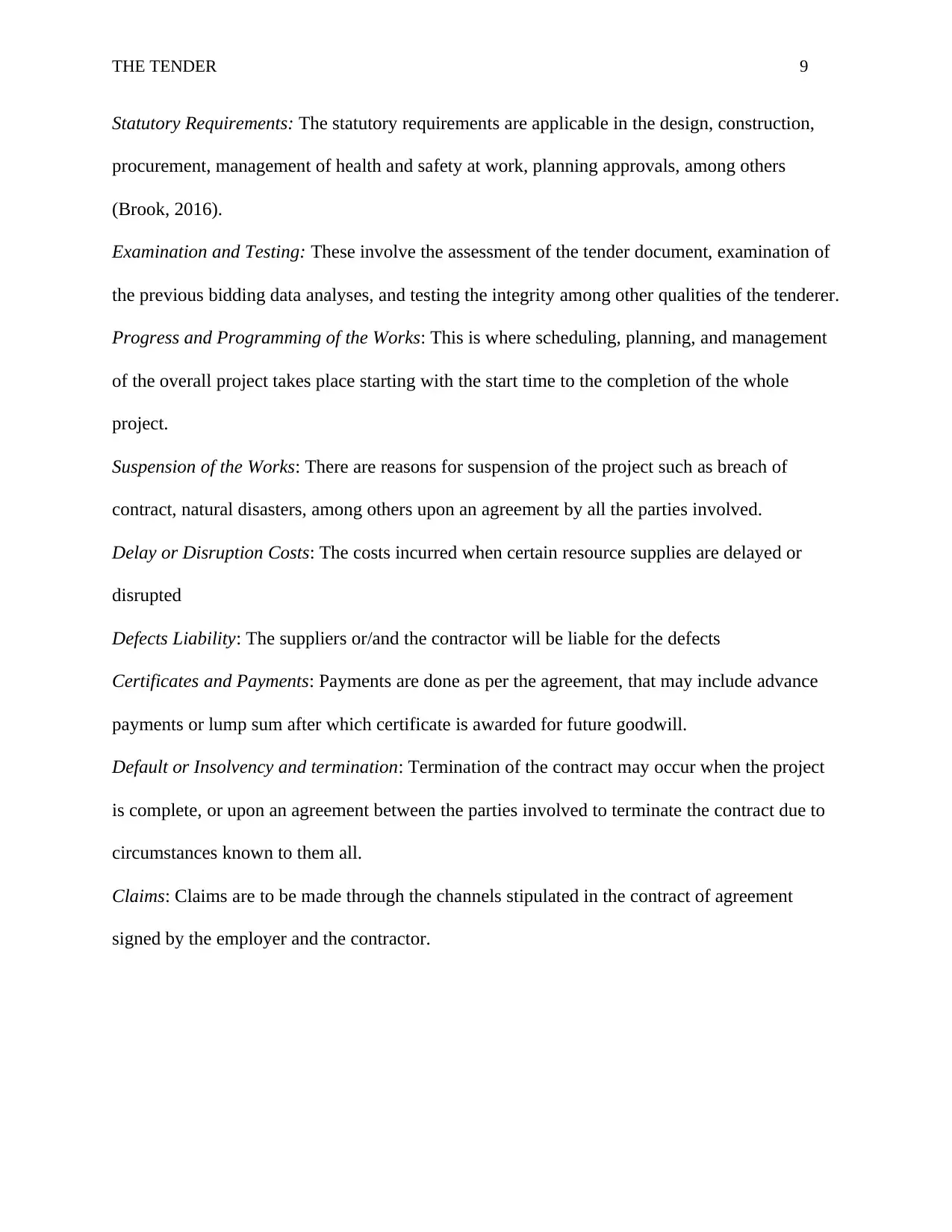
THE TENDER 9
Statutory Requirements: The statutory requirements are applicable in the design, construction,
procurement, management of health and safety at work, planning approvals, among others
(Brook, 2016).
Examination and Testing: These involve the assessment of the tender document, examination of
the previous bidding data analyses, and testing the integrity among other qualities of the tenderer.
Progress and Programming of the Works: This is where scheduling, planning, and management
of the overall project takes place starting with the start time to the completion of the whole
project.
Suspension of the Works: There are reasons for suspension of the project such as breach of
contract, natural disasters, among others upon an agreement by all the parties involved.
Delay or Disruption Costs: The costs incurred when certain resource supplies are delayed or
disrupted
Defects Liability: The suppliers or/and the contractor will be liable for the defects
Certificates and Payments: Payments are done as per the agreement, that may include advance
payments or lump sum after which certificate is awarded for future goodwill.
Default or Insolvency and termination: Termination of the contract may occur when the project
is complete, or upon an agreement between the parties involved to terminate the contract due to
circumstances known to them all.
Claims: Claims are to be made through the channels stipulated in the contract of agreement
signed by the employer and the contractor.
Statutory Requirements: The statutory requirements are applicable in the design, construction,
procurement, management of health and safety at work, planning approvals, among others
(Brook, 2016).
Examination and Testing: These involve the assessment of the tender document, examination of
the previous bidding data analyses, and testing the integrity among other qualities of the tenderer.
Progress and Programming of the Works: This is where scheduling, planning, and management
of the overall project takes place starting with the start time to the completion of the whole
project.
Suspension of the Works: There are reasons for suspension of the project such as breach of
contract, natural disasters, among others upon an agreement by all the parties involved.
Delay or Disruption Costs: The costs incurred when certain resource supplies are delayed or
disrupted
Defects Liability: The suppliers or/and the contractor will be liable for the defects
Certificates and Payments: Payments are done as per the agreement, that may include advance
payments or lump sum after which certificate is awarded for future goodwill.
Default or Insolvency and termination: Termination of the contract may occur when the project
is complete, or upon an agreement between the parties involved to terminate the contract due to
circumstances known to them all.
Claims: Claims are to be made through the channels stipulated in the contract of agreement
signed by the employer and the contractor.
⊘ This is a preview!⊘
Do you want full access?
Subscribe today to unlock all pages.

Trusted by 1+ million students worldwide
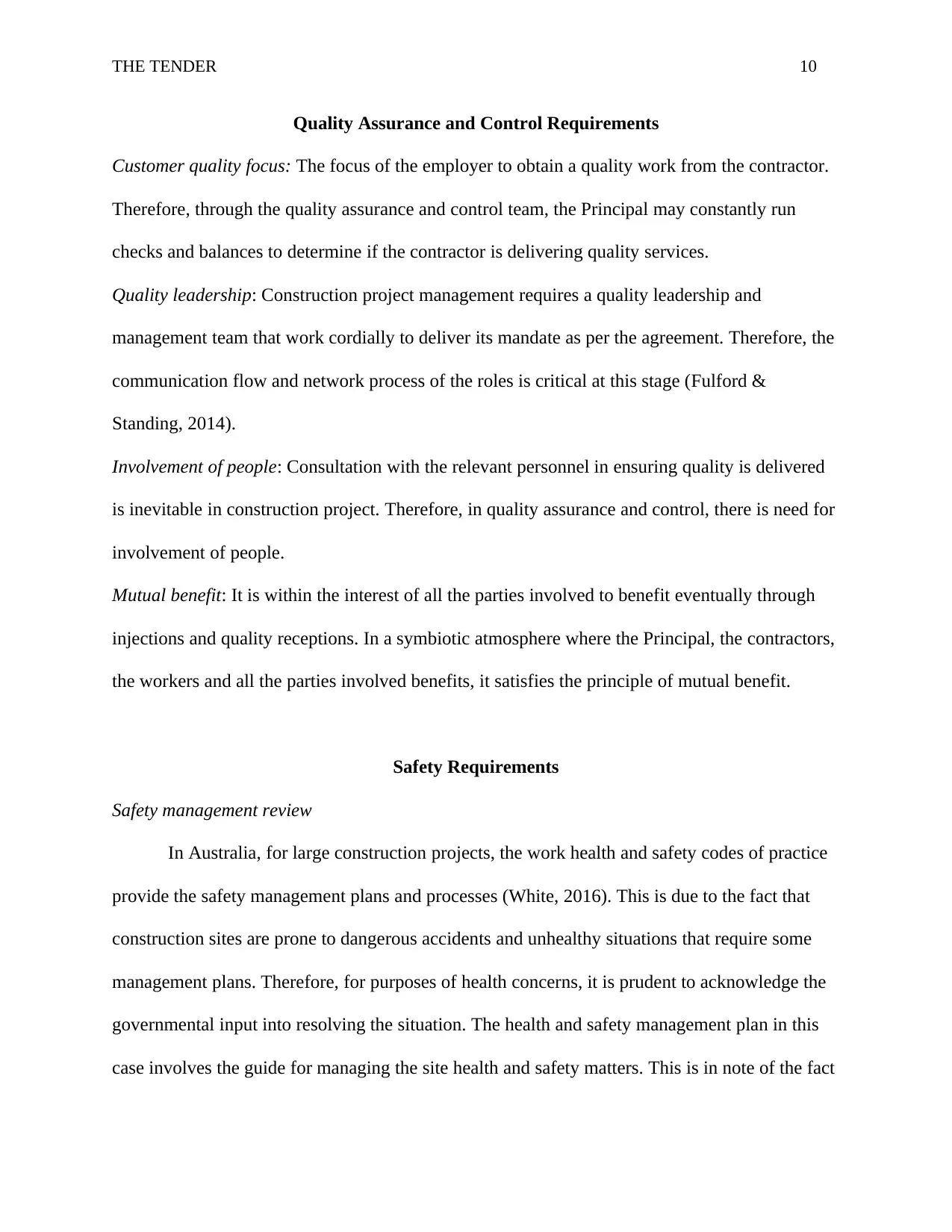
THE TENDER 10
Quality Assurance and Control Requirements
Customer quality focus: The focus of the employer to obtain a quality work from the contractor.
Therefore, through the quality assurance and control team, the Principal may constantly run
checks and balances to determine if the contractor is delivering quality services.
Quality leadership: Construction project management requires a quality leadership and
management team that work cordially to deliver its mandate as per the agreement. Therefore, the
communication flow and network process of the roles is critical at this stage (Fulford &
Standing, 2014).
Involvement of people: Consultation with the relevant personnel in ensuring quality is delivered
is inevitable in construction project. Therefore, in quality assurance and control, there is need for
involvement of people.
Mutual benefit: It is within the interest of all the parties involved to benefit eventually through
injections and quality receptions. In a symbiotic atmosphere where the Principal, the contractors,
the workers and all the parties involved benefits, it satisfies the principle of mutual benefit.
Safety Requirements
Safety management review
In Australia, for large construction projects, the work health and safety codes of practice
provide the safety management plans and processes (White, 2016). This is due to the fact that
construction sites are prone to dangerous accidents and unhealthy situations that require some
management plans. Therefore, for purposes of health concerns, it is prudent to acknowledge the
governmental input into resolving the situation. The health and safety management plan in this
case involves the guide for managing the site health and safety matters. This is in note of the fact
Quality Assurance and Control Requirements
Customer quality focus: The focus of the employer to obtain a quality work from the contractor.
Therefore, through the quality assurance and control team, the Principal may constantly run
checks and balances to determine if the contractor is delivering quality services.
Quality leadership: Construction project management requires a quality leadership and
management team that work cordially to deliver its mandate as per the agreement. Therefore, the
communication flow and network process of the roles is critical at this stage (Fulford &
Standing, 2014).
Involvement of people: Consultation with the relevant personnel in ensuring quality is delivered
is inevitable in construction project. Therefore, in quality assurance and control, there is need for
involvement of people.
Mutual benefit: It is within the interest of all the parties involved to benefit eventually through
injections and quality receptions. In a symbiotic atmosphere where the Principal, the contractors,
the workers and all the parties involved benefits, it satisfies the principle of mutual benefit.
Safety Requirements
Safety management review
In Australia, for large construction projects, the work health and safety codes of practice
provide the safety management plans and processes (White, 2016). This is due to the fact that
construction sites are prone to dangerous accidents and unhealthy situations that require some
management plans. Therefore, for purposes of health concerns, it is prudent to acknowledge the
governmental input into resolving the situation. The health and safety management plan in this
case involves the guide for managing the site health and safety matters. This is in note of the fact
Paraphrase This Document
Need a fresh take? Get an instant paraphrase of this document with our AI Paraphraser
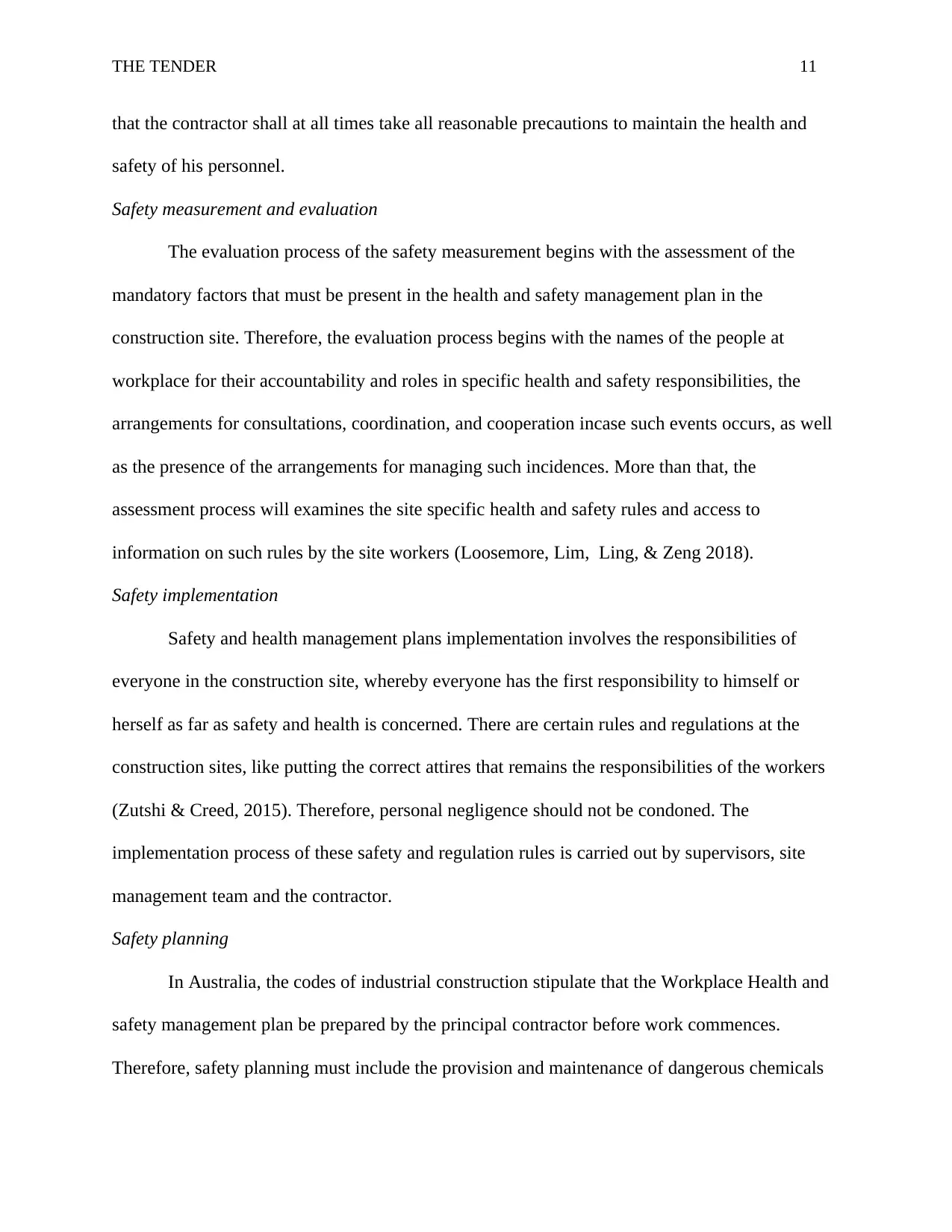
THE TENDER 11
that the contractor shall at all times take all reasonable precautions to maintain the health and
safety of his personnel.
Safety measurement and evaluation
The evaluation process of the safety measurement begins with the assessment of the
mandatory factors that must be present in the health and safety management plan in the
construction site. Therefore, the evaluation process begins with the names of the people at
workplace for their accountability and roles in specific health and safety responsibilities, the
arrangements for consultations, coordination, and cooperation incase such events occurs, as well
as the presence of the arrangements for managing such incidences. More than that, the
assessment process will examines the site specific health and safety rules and access to
information on such rules by the site workers (Loosemore, Lim, Ling, & Zeng 2018).
Safety implementation
Safety and health management plans implementation involves the responsibilities of
everyone in the construction site, whereby everyone has the first responsibility to himself or
herself as far as safety and health is concerned. There are certain rules and regulations at the
construction sites, like putting the correct attires that remains the responsibilities of the workers
(Zutshi & Creed, 2015). Therefore, personal negligence should not be condoned. The
implementation process of these safety and regulation rules is carried out by supervisors, site
management team and the contractor.
Safety planning
In Australia, the codes of industrial construction stipulate that the Workplace Health and
safety management plan be prepared by the principal contractor before work commences.
Therefore, safety planning must include the provision and maintenance of dangerous chemicals
that the contractor shall at all times take all reasonable precautions to maintain the health and
safety of his personnel.
Safety measurement and evaluation
The evaluation process of the safety measurement begins with the assessment of the
mandatory factors that must be present in the health and safety management plan in the
construction site. Therefore, the evaluation process begins with the names of the people at
workplace for their accountability and roles in specific health and safety responsibilities, the
arrangements for consultations, coordination, and cooperation incase such events occurs, as well
as the presence of the arrangements for managing such incidences. More than that, the
assessment process will examines the site specific health and safety rules and access to
information on such rules by the site workers (Loosemore, Lim, Ling, & Zeng 2018).
Safety implementation
Safety and health management plans implementation involves the responsibilities of
everyone in the construction site, whereby everyone has the first responsibility to himself or
herself as far as safety and health is concerned. There are certain rules and regulations at the
construction sites, like putting the correct attires that remains the responsibilities of the workers
(Zutshi & Creed, 2015). Therefore, personal negligence should not be condoned. The
implementation process of these safety and regulation rules is carried out by supervisors, site
management team and the contractor.
Safety planning
In Australia, the codes of industrial construction stipulate that the Workplace Health and
safety management plan be prepared by the principal contractor before work commences.
Therefore, safety planning must include the provision and maintenance of dangerous chemicals
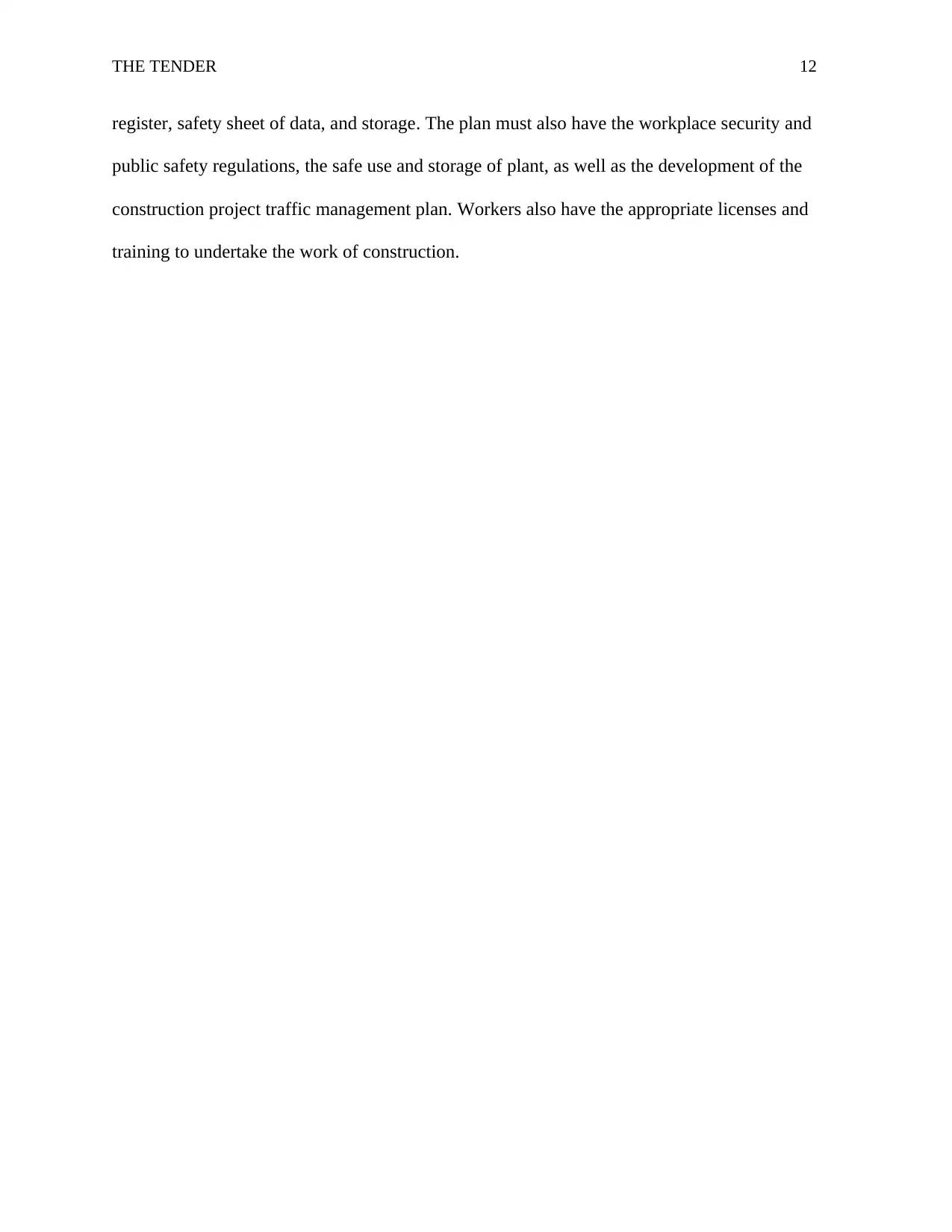
THE TENDER 12
register, safety sheet of data, and storage. The plan must also have the workplace security and
public safety regulations, the safe use and storage of plant, as well as the development of the
construction project traffic management plan. Workers also have the appropriate licenses and
training to undertake the work of construction.
register, safety sheet of data, and storage. The plan must also have the workplace security and
public safety regulations, the safe use and storage of plant, as well as the development of the
construction project traffic management plan. Workers also have the appropriate licenses and
training to undertake the work of construction.
⊘ This is a preview!⊘
Do you want full access?
Subscribe today to unlock all pages.

Trusted by 1+ million students worldwide
1 out of 14
Related Documents
Your All-in-One AI-Powered Toolkit for Academic Success.
+13062052269
info@desklib.com
Available 24*7 on WhatsApp / Email
![[object Object]](/_next/static/media/star-bottom.7253800d.svg)
Unlock your academic potential
Copyright © 2020–2025 A2Z Services. All Rights Reserved. Developed and managed by ZUCOL.





